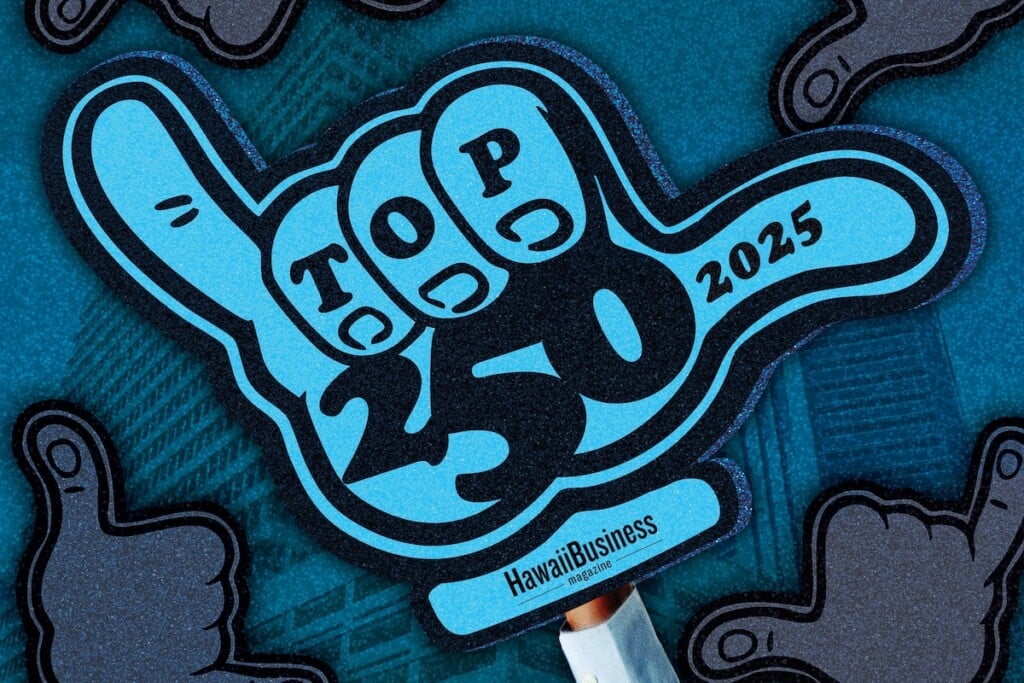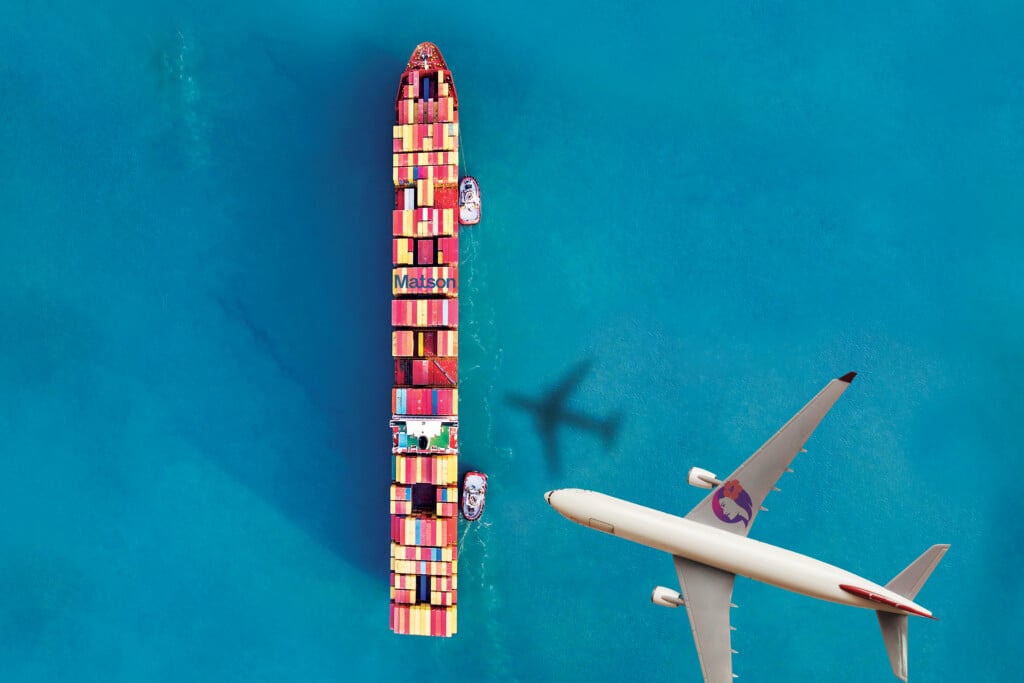A Year of Calm, With Uncertainty Ahead
Hawai‘i companies and nonprofits reported revenue gains in 2024 – a stable year before tariffs and federal funding cuts created a more volatile economic situation

Last year was like an oasis of calm for Hawai‘i’s economy. The ravages of the pandemic had faded and the economy grew. The destruction on Maui in 2023, which reverberated across the state, had turned into a building boom. And tariffs, funding cuts and deportations weren’t upturning business plans.
About 5,500 jobs were added in 2024, unemployment was at 2.9% and the number of visitors to the Islands had inched up to about 93% of pre-pandemic levels, according to a March 5 report from the state Department of Business, Economic Development & Tourism.
As measured by real gross domestic product, Hawai‘i’s economy finally exceeded pre-pandemic levels in 2024, by 1.5%, according to DBEDT.
These economic trends are reflected in the new Top 250 list, which reports 2024 gross revenue for many of Hawai‘i’s largest and most influential companies and nonprofits. The list serves as a bellwether of every important sector of the local economy and tracks the ups and downs of individual organizations.
Companies and nonprofits on the Top 250 list reported nearly 13% more revenue, on average, in 2024 than the previous year, based on self-reported and publicly available data. The nonprofit sector was up 44% on average, and construction and development companies were up 14%. Organizations in finance, health care, transportation, insurance and education saw average revenue increases of 7% to 13%.
Gross revenue in the real estate and retail and wholesale sectors increased more modestly, at about 2%, while tourism slipped by nearly 2%. Energy companies on the list saw the biggest slide, down 12% in 2024 on average from the previous year, in part because of falling fuel prices.
While 70% of Top 250 companies and nonprofits reported gains in 2024, economists are concerned about the current year. The UH Economic Research Organization downgraded projections for 2025 in a May 9 update:
“Hawai‘i’s economic outlook has taken a decisive turn for the worse, as expansive federal policy shifts look poised to tip the local economy into a mild recession. Sharp increases in U.S. import tariffs, sweeping federal layoffs, and volatile fiscal and immigration policies are undermining consumer confidence, raising inflation expectations and worsening the business outlook – both nationally and in Hawai‘i’s visitor-dependent economy.”

Goodfellow Bros.’ gross revenue increased 49% in 2024 in large part because of government infrastructure projects, including preparing a 57-acre site for the Ka La‘i Ola housing development in Lahaina | Photo courtesy: Goodfellow Bros.
How the state’s biggest organizations fared
Among the 10 largest organizations on this year’s list, health insurance giant HMSA, with nearly 800,000 members and $4.35 billion in gross revenue, ranked first – a position it’s held nearly every year over the past decade.
Health care insurers and providers on the list posted healthy gains in 2024, including HMSA at 5.2%. The health insurer traditionally spends most of the revenue it receives, and in its 2023 financial statement – the most recent one available – net income was just 0.2% of gross revenue.
Looking forward, health care providers such as Kaiser Permanente (No. 7), The Queen’s Health Systems (No. 9) and Hawai‘i Pacific Health (No. 10) could be affected by the domestic policy bill passed by Congress that calls for deep cuts to the federally funded Medicaid program.
About 21% of Hawai‘i residents are enrolled in Medicaid, and cuts would hurt beneficiaries as well as strain state spending, health care and nursing facilities, and clinicians, according to the Johns Hopkins Bloomberg School of Public Health.
Servco jumped to the No. 2 spot on the Top 250, posting $3.86 billion in gross revenue in 2024 – a 20% increase from the previous year. According to an email from Servco executives, the growth comes from acquiring car dealerships in Hawai‘i and Australia: Big Island Toyota, with dealerships in Hilo and Kona, and the Motorama Dealership Group, with 18 locations across the state of Queensland.
In third position is Alaska Airlines and Hawaiian Airlines, which for the first time reported combined income for its Hawai‘i-based operations: more than $3.8 billion in 2024. Alaska Air Group Inc. completed its acquisition of Hawaiian Holdings Inc. on Sept. 18, 2024.
But a slowdown in international travel is expected to impact all the airlines serving Hawai‘i. A DBEDT report from May 28 says the total number of air seats to Hawai‘i will likely drop by 0.5% in 2025, based on airline flight schedules.
In contrast to the higher Alaska-Hawaiian revenue in 2024, Hawaiian Electric Industries (No. 6) sold 90.1% of its ownership interest in American Savings Bank at the end of last year. The company excluded ASB’s revenue when reporting 2024 data for the Top 250 list, which shows gross revenue down 12.6% from the previous year, at $3.2 billion.
Scott Seu, president and CEO of HEI, announced on Dec. 31, 2024, that the sale allows the company “to use the proceeds to reduce holding company debt, increasing flexibility for how HEI funds the HEI and Hawaiian Electric wildfire settlement contributions and key utility initiatives.”
In February of this year, the company agreed to pay about half of a $4 billion settlement to compensate victims of the 2023 Maui wildfires. In the profit/loss section of the Top 250 survey, HEI reported a nearly $1.43 billion net loss in 2024.
Matson (No. 5) had a strong year, with more than $3.4 billion in gross revenue in 2024, up 10.6% from the previous year. The main factor driving growth was its shipping lines between China and Long Beach, Calif., which saw a small increase in volume and a more significant increase in freight rates, according to the company’s fourth-quarter conference call with investors.
Rates were hiked globally last year after Yemen-based Houthis launched attacks on ships in the Red Sea, which disrupted the critical international trade route and caused delays and congestion, longer alternate routes and higher insurance costs.
In late February of this year, Matson released upbeat statements about the company’s 2024 results and projections for the current year. But those projections changed on May 5 when it posted its first-quarter results for 2025, about a month after the Trump administration imposed “reciprocal tariffs” on trading partners:
“Currently, there is significant uncertainty regarding tariffs and global trade, regulatory measures, the trajectory of the U.S. economy and other geopolitical factors. Since the tariffs were implemented in April, the company’s container volume has declined approximately 30% year over year,” wrote Chairman and CEO Matt Cox.
As of May 14, average U.S. tariffs on Chinese imports were 51%, according to the Peterson Institute for International Economics, after spiking to 145% on April 9.
In a final note about the top 10 organizations on this year’s list, the University of Hawai‘i System (No. 8) reported $2.2 billion in gross revenue in 2024, up 8.4% from the year before. But the flagship research campus at UH Mānoa, in particular, is now dealing with federal funding cuts, many targeting scientific research.
In a May 22 statement, UH President Wendy Hensel said that 69 federally funded grants had been terminated, representing about $83.4 million in funding and impacting more than 90 employees. Other grants received stop-work orders or drawdowns.
“As expected, the number and scale of terminations is accelerating and will undoubtedly take a significant toll on the university,” the statement said.
Construction remains a bright spot
Even in the depths of the pandemic, Hawai‘i’s busy construction companies were a lifeline in a flagging economy. The industry continues to be strong, with expectations for growth in 2025.
On this year’s Top 250 list, gross revenue among construction and development companies was up 14% on average in 2024. The number of payroll jobs in construction increased 9.2% in 2024 compared to 2023, according to estimates by DBEDT.
UHERO’s May 9 report says that public infrastructure projects and rebuilding on Maui have contributed to the industry’s growth, which can be seen on the Top 250 list.
Hensel Phelps (No. 20), for example, reported a 47% increase in gross revenue last year over the previous year, to about $560 million. In a note to Hawaii Business Magazine, the company says it expanded into education and health care construction, including major projects with Kaiser Permanente, UH Mānoa and the state Department of Education.
Maui-based construction company Goodfellow Bros. (No. 25) also saw huge growth in 2024, with gross revenue rising 49% to $452 million. Hawai‘i Division President Edward Brown says government contracts made up about 60% of the company’s business last year.
Among its projects, the company worked with the U.S. Army Corps of Engineers to clear the Lahaina burn zone last year. It also worked with the state on infrastructure for the Ka La‘i Ola housing development, including building a massive water tank, blasting rocks and grading the site, and installing transmission lines.
It was a major undertaking – “a seven-day-a-week, 10-hour-days, fast-track project,” he says. The first occupants received keys to their temporary homes a year after much of Lahaina was destroyed.
And Goodfellow Bros. has been inundated with military projects, says Brown, including updates to water and sewer lines at housing complexes, as well as work on a “massive facility” to repair submarines on O‘ahu and a major Space Force facility on Maui.
“You’re going to see a huge influx of money coming in from the military in the next few years,” he says.
On Moloka‘i, the company is creating residential lots for the state Department of Hawaiian Home Lands. And on Lāna‘i, it’s working with Oracle co-founder Larry Ellison, who owns 98% of the island, on updates to his vast estate, as well as community improvements such as roads, water lines, a health center and amphitheater.
Brown says tariffs haven’t affected Goodfellow Bros.’ business yet, and the immediate future looks promising. But some challenges persist: “It still takes a lot to get things going in Hawai‘i. Permits take a long time, entitlements take a long time. People who are successful here are the ones who are patient.”
DBEDT forecasts that construction will be strong in coming years. It says the number of residential housing units authorized in 2024 increased by 78% from 2023, and more than 1,000 hotel units were under construction or expected to start construction soon.
But a UHERO forecast sees tariffs on imported materials plus labor constraints weighing on future activity, with construction employment starting to recede by 2027.
Maui recovery lifts CNHA and other nonprofits
Some of the largest nonprofits on this year’s Top 250 list are also actively involved in Maui recovery efforts.
The state’s biggest nonprofit, the Hawai‘i Community Foundation (No. 76), raised more than $114 million in 2024 and awarded $92 million through its Maui Strong Fund to organizations working in housing, health and social services, and other initiatives.
But its overall revenue in 2024 was less than half of what it was in 2023, when a surge of donations poured in from around the world after the Aug. 8 wildfires.
Other nonprofits involved in the recovery saw dramatic growth in 2024, including the Council for Native Hawaiian Advancement (No. 96), the Maui Food Bank (No. 102) and Maui Economic Opportunity (No. 130).
CNHA’s revenue jumped 91% in 2024, to nearly $86 million, putting it third among charitable nonprofits after HCF and the UH Foundation. The organization has diversified its operations and uses a “fee for hire” model instead of billing for services at completion, says CEO Kūhiō Lewis.
He says the increase in revenue is directly related to its expansion on Maui, which includes opening in-person resource centers and temporary housing units and helping people with rental assistance, building permits and legal advice.
“When there’s a need, we jump at it and make it happen, and people want to support that work. The work comes to us,” says Lewis.
In recent years, the organization has moved into tourism management with large contracts from the Hawai‘i Tourism Authority, expanded loan programs that it oversees as a federally funded community development financial institution, and increased offerings at its Hawaiian Trades Academy.
“We’re creating an ecosystem,” says Lewis. “We have a loan fund that supports business development. We have workforce development, which supports construction-related projects that we’re working on. All of the different tentacles support our growth.”
Another growth area is the organization’s asset portfolio, which now includes apartment buildings and landholdings, says Lewis. In 2024, for example, CNHA acquired 44 acres in the Kaumana neighborhood in Hilo, where it plans to develop workforce housing.
Lewis says he and his organization try “to fill the voids” in Hawai‘i and develop programs based on their lived experiences, including the difficulties of trying to support a family or buy a home – hardships that Lewis faced himself as a young single father.
“I like to challenge the status quo, to refine the way of doing things,” says Lewis. “I’ve seen how things don’t work, so we’re doing things differently.”
As for the future, he says, the organization has spent the post-pandemic years becoming more self-sufficient through private- and public-sector contracts and revenue-generating operations. “We might lose $1 million or $2 million in 2025, but we have lots of other legs to stand on.”
How We Compile the Top 250
Top 250 companies and nonprofits are ranked by gross sales or gross revenue, key indicators of market strength and influence.
Each spring, Hawai‘i Business Magazine surveys companies in our database and gathers updated financial figures, employee counts, names of executives and other information.
Businesses are asked to calculate gross sales using generally accepted accounting principles, while nonprofits report contributions to revenue, funding for services and/or proceeds from activities that support their missions. Each business and nonprofit provides the name of an executive who verifies the self-reported figures.
Companies headquartered in Hawai‘i report sales from all of their subsidiaries worldwide; those based elsewhere report Hawai‘i figures only. While we prefer calendar year data, some organizations operate on a fiscal year.
To supplement the survey process, we draw on public records such as annual reports, financial statements, databases of the Federal Deposit Insurance Corp. and National Credit Union Administration, and insurance figures from the state Department of Commerce and Consumer Affairs.
Some companies with large local presences don’t appear on the list. Those omissions often happen when offshore parent companies can’t or won’t supply data for their Hawai‘i operations, or when companies are privately held and do not disclose financial information.
Top 250 executives are surveyed and profiled in our Black Book issue each December.
 The complete Top 250 rankings are only in the August print issue of Hawaii Business Magazine.
The complete Top 250 rankings are only in the August print issue of Hawaii Business Magazine.






